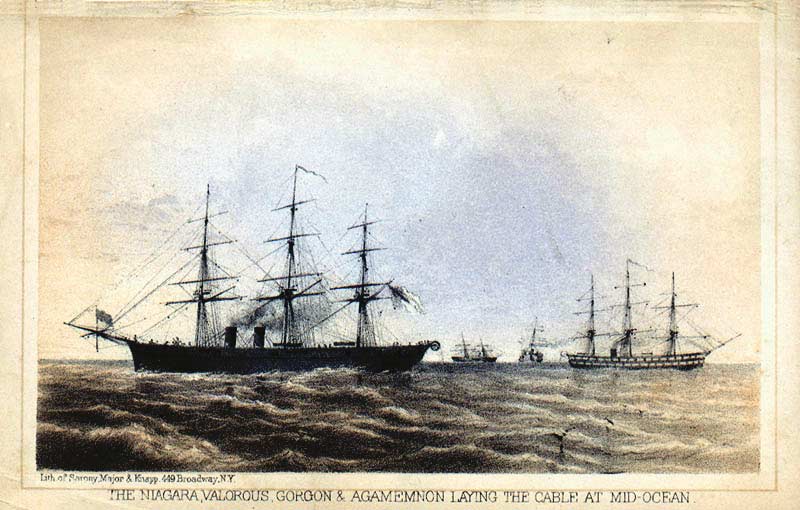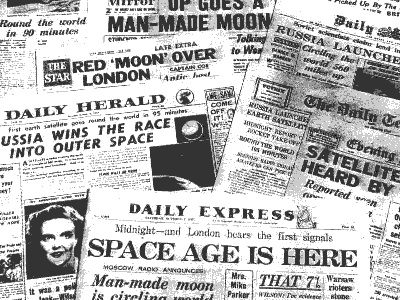The manufacture of the cable started in early 1857 and was completed in June. Before the end of July it was stowed on the American "Niagara" and the British "Agamemnon" -- both naval vessels lent by their respective governments for the task.

Although the laying of this first cable was seen as a landmark event in society, it was a technical failure. It only remained in service a few days. Subsequent cables laid in 1866 were completely successful and compare to events like the moon landing of a century later... the cable ... remained in use for almost 100 years.
Smithsonian's National Museum of American History.
A brief look from 1997: Annual percentage growth rate of data traffic on undersea telephone cables: 90. Number of miles of undersea telephone cables: 186,000 Source: WinTreese
 1957 - October 4th - the USSR launches Sputnik, the first artificial earth satellite: 
In 1962, Dr. J.C.R. Licklider was chosen to head ARPA's research in improving the military's use of computer technology. Licklider was a visionary who sought to make the government's use of computers more interactive. To quickly expand technology, Licklider saw the need to move ARPA's contracts from the private sector to universities and laid the foundations for what would become the ARPANET. The Internet as a tool to create "critical mass" of intellectual resourcesTo appreciate the import ante the new computer-aided communication can have, one must consider the dynamics of "critical mass," as it applies to cooperation in creative endeavor. Take any problem worthy of the name, and you find only a few people who can contribute effectively to its solution. Those people must be brought into close intellectual partnership so that their ideas can come into contact with one another. But bring these people together physically in one place to form a team, and you have trouble, for the most creative people are often not the best team players, and there are not enough top positions in a single organization to keep them all happy. Let them go their separate ways, and each creates his own empire, large or small, and devotes more time to the role of emperor than to the role of problem solver. The principals still get together at meetings. They still visit one another. But the time scale of their communication stretches out, and the correlations among mental models degenerate between meetings so that it may take a year to do a week’s communicating. There has to be some way of facilitating communicantion among people wit bout bringing them together in one place. The Computer as a Communication Device by J.C.R. Licklider, Robert W. Taylor, Science and Technology, April 1968. | ||
1969: The first LOGs: UCLA -- Stanford According toVinton Cerf: ...the UCLA people proposed to DARPA to organize and run a Network Measurement Center for the ARPANET project... Around Labor Day in 1969, BBN delivered an Interface Message Processor (IMP) to UCLA that was based on a Honeywell DDP 516, and when they turned it on, it just started running. It was hooked by 50 Kbps circuits to two other sites (SRI and UCSB) in the four-node network: UCLA, Stanford Research Institute (SRI), UC Santa Barbara (UCSB), and the University of Utah in Salt Lake City. | ||
 | ||
| The plan was unprecedented: Kleinrock, a pioneering computer science professor at UCLA, and his small group of graduate students hoped to log onto the Stanford computer and try to send it some data.They would start by typing "login," and seeing if the letters appeared on the far-off monitor. | ||
"We set up a telephone connection between us and the guys at SRI...," Kleinrock ... said in an interview: "We typed the L and we asked on the phone, "Do you see the L?" "Yes, we see the L," came the response. "We typed the O, and we asked, "Do you see the O." "Yes, we see the O." "Then we typed the G, and the system crashed"...
Yet a revolution had begun"...
| ||
In late 1971, Larry Roberts at DARPA decided that people needed serious motivation to get things going. In October 1972 there was to be an International Conference on Computer Communications, so Larry asked Bob Kahn at BBN to organize a public demonstration of the ARPANET.
About one - two years after the first online demo of how "actually let the public come in and use the ARPANET, running applications all over the U.S ...." (Vinton Cerf) the NET became really busy especially "every Friday night" (Bob Bell)
Around about 1973 - 1975 I maintained PDP 10 hardware at SRI.
I remember hearing that there was an ARPANET "conference" on the Star Trek game every Friday night. Star Trek was a text based game where you used photon torpedos and phasers to blast Klingons.
I used to have a pretty cool logical map of the ARPANET at the time but my ex-wife got it. (She got everything but the debts.)
Bob Bell
DEC Field Service
| It seems we found "a pretty cool logical map of the ARPANET" which Bob has kindly reminded us about . Thanks, Bob! | |
 | |
Logical map of the ARPANET, April 1971
| |
- 1958 Advanced Research Projects Agency (ARPA) created by Department of Defense (DoD).
- 1961 Director of Defense Research and Engineering (DDR&E) assigns a Command and Control Project to ARPA.
- 1962 Information Processing Techniques Office (IPTO) formed to coordinate ARPA's command and control research.
- 1972 ARPA renamed Defense Advanced Research Projects Agency (DARPA).
- 1986 The technical scope of IPTO expands and it becomes the Information Science and Technology Office (ISTO).
- 1991 ISTO splits into the Computing Systems Technology Office (CSTO) and the Software and Intelligent Systems Office
The Internet has changed the way we currently communicate...
But could the Internet have performed the function it was originally designed for? |
| ||
| The Internet Post-Apocalypse There's a common myth that the Internet could survive a nuclear attack. If the Internet, or pieces of it, did withstand such a war, how would it be used post-apocalypse? Would the Internet itself be used to wage war? Would it become a sole source of information for the surviving masses?Or would it be too cluttered with dead sites and falsehoods to be worth anything? | ||
| . | The point that I do want to dust off and raise again is that ARPA wouldn't have happened, if what used to be the Soviet Union hadn't shaken complacent U.S. awake with a tin can in the sky, Sputnik. Wars do wonders for the advancement of technology, and the Cold one was certainly no exception. The way to get a technology advanced is to gather a lot of really smart people under one roof and get them to concentrate on a single project. Of course, that takes some organization and money. Where does that come from? But that's another can of worms - to be opened with relish at a later date. In this case, it was the only body that had a stake in making sure the Net worked - the government. What with the Cold War in full swing and all, the military, specifically its think tank the Rand Corporation, was concerned that if the war ever got hot and large chunks of the country were vaporized, those phone lines (not to mention considerable segments of the population) would be radioactive dust. And the top brass wouldn't be able to get in touch and carry on. Thus the packets bouncing from node to node, each of those nodes able to send, receive and pass on data with the same authority as any other. It was anarchy that worked, and on a technical level, it still does, obviously. |
'REWIRED' by David Hudson,
JOURNAL OF A STRAINED NET, August 9th, 1996 | |
| ||||||||||||||||||||||||||||||||||||||
Gore has become the point man in the Clinton administration's effort to build a national information highway much as his father, former Senator Albert Gore, was a principal architect of the interstate highway system a generation or more earlier.
Principal Figures in the Development of the Internet ...
The University of North Carolina at Chapel Hill
.
24 Jun 1986: Albert Gore (D-TN) introduce S 2594
Supercomputer Network Study Act of 198621 March 1994: Gore's Buenos Aires Speech
International Telecommunications Union:"By means of electricity, the world of matter has become a great nerve, vibrating thousands of miles in a breathless point of time ... The round globe is a vast ... brain, instinct with intelligence!"
This was not the observation of a physicist--or a neurologist. Instead, these visionary words were written in 1851 by Nathaniel Hawthorne, one of my country's greatest writers, who was inspired by the development of the telegraph. Much as Jules Verne foresaw submarines and moon landings, Hawthorne foresaw what we are now poised to bring into being...
... I opened by quoting Nathaniel Hawthorne, inspired by Samuel Morse's invention of the telegraph. Morse was also a famous portrait artist in the U.S.--his portrait of President James Monroe hangs today in the White House. While Morse was working on a portrait of General Lafayette in Washington, his wife, who lived about 500 kilometers away, grew ill and died. But it took seven days for the news to reach him.
In his grief and remorse, he began to wonder if it were possible to erase barriers of time and space, so that no one would be unable to reach a loved one in time of need. Pursuing this thought, he came to discover how to use electricity to convey messages, and so he invented the telegraph and, indirectly, the ITU."


ane izin baca dulu ya sob.... seprti seru juga nih.....
ReplyDelete